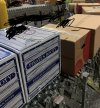Maybe i missed where she said 1 hour unload but she has mentioned that they get they get both trucks, or triples, done within the 4.5 hours of the unload shifts. But with the line being set up and doing both trucks back to back im assuming with a quick 15 in the middle of the 2 thats still 2 hours per truck. Even seen her mention doing multiple trucks at once. Thats not a possibility in my store but you shouldnt be taking more then 2 hours with a fully staffed inbound team. Also a+a shouldnt be taking up your time as you should just sending them down the line and taken off to have them sort it out, mayne your team doesnt have enough space allocated? We had that problem at the start.
We have the same amount of people on the line but you should also have a person running the bulk pallets of the truck during unload, and my bath tm pushes the excess beds/bath on the p2 side as well as the domestics repacks during unload which really helps prevent clutter during unload.
We have the same amount of people on the line but you should also have a person running the bulk pallets of the truck during unload, and my bath tm pushes the excess beds/bath on the p2 side as well as the domestics repacks during unload which really helps prevent clutter during unload.

